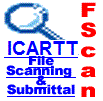A. FScanBrowser
**FScan assumes that the user is familiar with the ICARTT Data Format Document.**
FScan is a web-based application designed specifically to handle ICARTT formatted files.
The Submittal function of FScan ensures that all data files submitted to the
Archive are in compliance
with the ICARTT Data
Format Document.
» Click here to access FScan 
A. FScanBrowser:
This application offers similar services (except archiving) as FScan; but also offers many other options that are not available in the web-based FScan. For example,
1. Fast Plotting feature: allows user to visually view the data with just a click of the Mouse.
2. XY Plotting/Correlation: by simply selecting 2 items from lists.
3. The user can Print and/or Save charts. The charts can also be re-scaled by simply clicking on the Y or X axis; the user can even zoom in to a single point on the charts.
4. Plus many other options.This is a standalone application, Windows-based, no installation required, runs on the user (local) machine. Users are encouraged to run this application on their files prior to using the web-based FScan (to conserve network bandwidth usage). Click here to download.
FScan has 2 primary functions: (1) Scanning and (2) Archiving.
The Scanning function receives the file from the user and then does a thorough examination on the file to ensure it is in compliance with the ICARTT Data Format. During Scanning: the file is checked line-by-line, value-by-value, and in some cases letter-by-letter; and if problems are found then error messages are displayed in RED text along with the line numbers and reasons. If the file doesn't have errors, the Archival function is invoked.
The Archival function is invoked when file Scanning produced no errors.
After that, PI's registered
dataIDs are retrieved and compared with the
file being submitted. Based on the comparison, PI Data Directory is then created
and the file is archived in that directory.
In order to archive PI files: (1) dataIDs must be registered first because the PI Data Directory on the Server is created from the registration. Please make sure all PI's dataIDs are registered. And (2), the filename must adhere to the ICARTT file naming convention. Please make sure you use ONLY defined file extensions and loactionIDs.
|More Info...|
*.ict, *.nc, *.cdf, *.hdf, *.h4, *.h5, *.hdf4, *.hdf5
|
"DC8", "P3B", "J31", "C130", "NP3", "BE200", "PROTEUS", "CESSNA", "MODEL", "SATELLITE", "O3SONDES", "GROUND", "LIGHTNING", "TRAJECTORY",
etc.
The exact LocationIDs and their definitions are usually mission specific and established by the Data Manager. For NASA missions, LocationIDs are defined when the "dataIDs registration" process is set. The exact definitions can be viewed on the dataIDs Registration Page. |
1. Register PI's dataIDs if you want the files to be placed in the Archive (NASA LaRC).
2. Select "Scan Only" OR "Scan and Archive" (self-explanatory).
3. Upload File -- Upload your file directly from your machine (self-explanatory). FScan also accepts *.zip files. If your file is > 2 Mbytes for example, consider zipping it.
To archive *.zip ICARTT file: create a zip file of the ICARTT file you want to submit. The zipped filename must match the ICARTT filename (the file inside it) but with the “.zip” extension (e.g., O3_dc8_20040701_r0.zip). This zipped file must NOT contain more than 1 (one) ICARTT data file.
To submit multiple files in one step: simply create a zip file containing your ICARTT compliant files. The zipped filename can be any valid filename (NO SPACES) with the extension “.zip” (e.g., all_my_files.zip). FScan will unzip the compressed file and archive the data files appropriately. This zipped file must contain at minimum 2 files but NOT more than 255 files. The files inside this zipped file can also be of type *.zip (see note above: To archive *.zip ICARTT file).4. The ICARTT Data Format defines these file types: FFI 1001, FFI 2110, and FFI 2310. Using any of these file types, you still need to select the "Time Sampling" method used: "Start, Stop, and Mid-point" OR "Constant Equal (1 or less); {Or, irregular (Satellite/Trajectory/Ground)}". The default method FScan assumes is "Start, Stop, and Mid-point".
Please consult the ICARTT Data Format Document for details, and to view examples.
And finally, press the "Submit" button.
Once FScan has finished, a report is generated detailing ALL information interpreted from your file. Please pay special attention to the RED text (and/or suggestions from FScan) to correct your files.
Please Note (more info on file extension):
1. If the submitted file's extension is any of the defined file extensions (see above) but not “.ict” or ".zip", (and if Scan and Archive is selected), then the file will be moved directly to PI's directory WITHOUT SCANNING.
2. The recommended minimum filename requirement for files with the extensions ".txt", *.pdf", "*.kmz", "*.xls", "*.jpg", etc. is: dataID_locationID_comments.ext (e.g., nav_dc8_readme.txt)